Photo

(Photo by Sharon McCutcheon)
Just because I like it
0 notes
Text
Mainstream media vs alternative media (as in: MSNBC vs Anti-Media)
Although I’m not a regular reader of either of the above example news outlets, my habit IS to check mainstream media (MSM) first and then turn to an alternative site or two. Maybe that’s why, when considering mainstream vs alternative media, I’m reminded of the Tolstoy quote, “Happy families are all alike; every unhappy family is unhappy in its own way.” Side by side, any two MSM news sites (‘happy families’) will differ only in appearance, brand personality or spin, and order of precedence for what are essentially identical topics and commentary. Between alternative news sites (‘unhappy families’), the themes and angles are as unpredictable as the events that bring them about: Snowden and Assange are Nobel Peace Prize nominees; Tulsi Gabbard is bravely tackling Big Pharma; A UFO was seen by ….. (that last one is my example.) The family metaphor could be taken further, as the establishment is not exactly a supportive ‘parent’ for alternative media, but this brief comparison report will revolve instead around approach, reputation and audience.
Generally, our mainstream US news outlets aim for responsible commentary on the latest official press releases or on whatever the AP wire is spitting out; they don’t have to consider what the public WANTS to hear unless they’re covering entertainment news. That pretty much describes MSNBC, to be sure, whether its commentary is actually responsible or not.
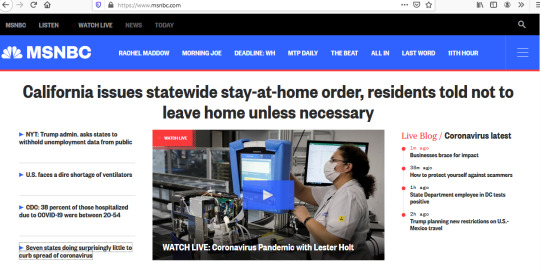
At the more popular end of the news spectrum, MSNBC, in a nutshell, is the cable news network that launched in 1996, gained national recognition and popularity during Obama’s presidency, and became part of the MSM. Today, as part of the NBCUniversal media conglomerate, it’s the politically liberal cable and satellite network that “provides news coverage and political commentary from NBC News on current events.” It is also “the second-most-watched network on all of basic cable.”
In contrast…. what if the team at a news outlet thinks that Americans want the truth and are not getting it? And what if that team makes a habit of defying standard press releases and seeking their own news sources? Well, that pretty much describes Anti-Media.
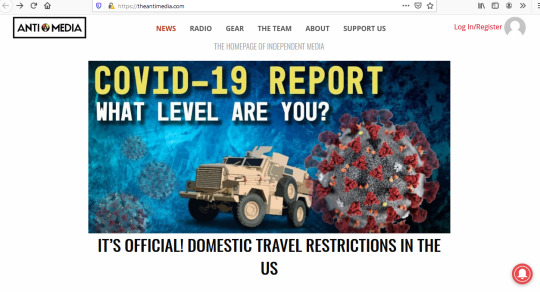
Anti-Media started as an anti-establishment Facebook page that gained millions of followers, over two hundred million website visits, and partnerships with other independent news outlets. This “non-partisan, anti-establishment news publisher” now bills itself as “the homepage of independent media,” and its name certainly matches that title. Anti-Media’s “very shareable newsclip videos” are popular on Facebook, and, using a voting system, its website users can submit news items and decide where they appear on the home page.
The content of non-MSM outlets differs greatly from that of MSM outlets, partly because the sources considered to be reputable are different for each, although, quite often, a source is the same for both but the takeaway is not. A good example of this is seen in the homepage headlines for MSNBC and Anti-Media (above), which also illustrate a typical difference in how the two types of media platform interpret the same topic.
* * * * * *
Despite news providers like Anti-Media, most of us rely only on our major (MSM) news outlets, such as CBS, ABC, CNN, Fox, and others that enjoy the same universal acceptance. These familiar brands park outside the White House for political tidbits, consult only mainstream experts for news-related perspectives, and avoid offending the industries and companies that provide their advertising revenue. The conflict of interest caused by this advertising (and the reason all media should be independent) is completely ignored.
On the other hand, with no advertisers to offend, independent media freely consults non-MSM experts with equal credentials, whistleblowers, and even certain foreign news sources with less censorship. It can also look behind the MSM wizard’s curtain and ask critical questions, like, ‘Any conflicts of interest between the sources of data and the issue?’ ‘Do we really need this new law/vaccine/red tape/loss of freedom?’ ‘Is there a CURRENT, fully independent, accessible study?’ And my personal favorite: ‘What else is going on as everyone focuses on this?’
The Audience Factors
Operating outside of the status quo, alternative media is normally dismissed by MSM channels as the unreliable work of frauds, “conspiracy theorists” and amateurs. Maybe that’s part of why it’s easy to think that readers of independent media are simply malcontents who don’t trust ANY authority. However, as of 2017, 35% of Americans have turned to online alternative media due to mistrust of MSM news, and some alternative news channels have surpassed MSM outlets, including MSNBC, on YouTube:
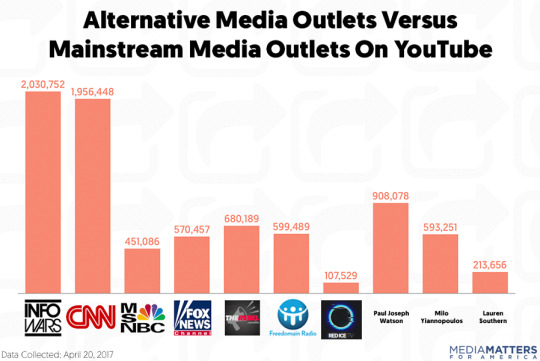
While viewers of alternative news seem to transcend typecasting, it might be safe to assume that many are truthseekers who crave authenticity and fairness more than most, and that their characteristics may include a sense of rebellion and adventure. Meanwhile, demographics are readily available for specific MSM audiences; MSNBC viewers, for example, are likely to be moderate or liberal White Democrats who attended college and are over 35. However, as the great majority, the overall MSM audience comprises the broadest of U.S. demographics.
The Marketing Factor
Although the main differences between mainstream and alternative news providers relate to dependence on large corporate advertisers, many alternative sites rely on smaller advertisers whose products and services complement their platform without creating dependence or obligation. If your products are in another ‘alternative’ category, such as alternative health, all the better; in my experience, those looking away from the mainstream are usually doing so in more areas than one. But even if your product or service doesn’t seem to be for this crowd, perhaps your message can still reach them. I believe that marketing communications can always be tweaked (and most of them should be) to appeal to the need for truth and what is right.
0 notes
Text
Late to The Pin Party, Standing Outside
When it comes to Pinterest, I have no interest - probably because it always gave me the impression of an arts-and-crafts forum where people shared primarily images of teal pots, crotcheted anything, and flowery everything else. Just not my thing, although I know the forum is host for a great variety of themes in addition to those. Therefore, this week’s approach had to be different, and I decided to look at the social media platform from the viewpoints of those who do use it and those who give advice about it.

(And did I mention I hate online food displays because I don’t cook and I can’t taste the food through the screen?)
Depending on the source of data, Pinterest is either the fourth or the fifth most popular social media site in the U.S.,with anywhere from 66 million to 88 million users. This image-sharing site, launched in 2010 as a way to share “ideas and inspiration for various interests and projects,” allows its users (called “Pinners”) to “pin” personally-selected digital images onto their own virtual wall. Accordingly, although it’s “the only social media platform to offer visual search,” its CEO considers Pinterest a “visual discovery tool” rather than a social media forum. According to his 2019 IPO filing, women account for two-thirds of Pinners, and a somewhat startling claim by Pinterest, which I personally doubt, is that it’s users include 80% of US mothers. Surely, this claim should be put into context, as it is likely that the Pinterest team is referring only to mothers of underage children.

(The Pinterest Pinterest page (easier to say than “Pinterest’s Pinterest page”), trying to lure me with ‘womany’ stuff.)
My sidelong look at the platform began with neutral consumer-review sites where Pinterest users are free to criticize and praise at a safe distance from their accounts, and on these uncensored sites, Pinterest rates quite low:

In fact, it rates much lower than I would have guessed; Trustpilot shows 1.5 out of 5 stars:
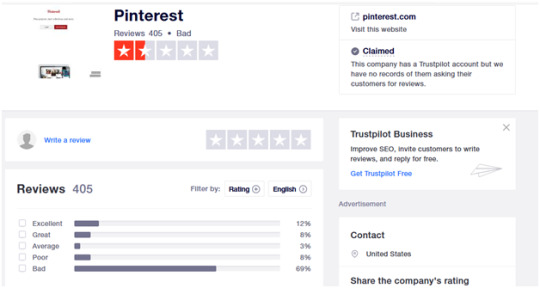
And the reviews are very believable, showing what Pinterest used to be as well as what it has become…. The following two are from the review site, Trustpilot:
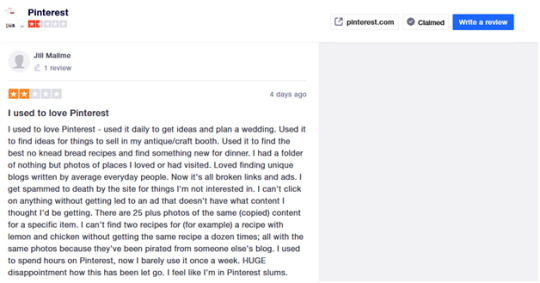

Maybe this post from Jay, also on Trustpilot, indicates well where Pinterest is headed:

In the very large amount of negative reviews, far too many to post here, a few important themes stand out, and the Pinterest team will be losing out even more if it doesn’t turn things around. In short, reviews show that, for many Pinners, Pinterest has been “destroyed” by excessive and intrusive ads, lack of action with stolen images, extreme censorship, irrelevant suggested pins, and customer “service” reps who couldn’t care less (if they are even available).
It’s important to note that sites with mostly positive ratings are not committed to neutral reviews, or they are tied either to Pinterest or to app downloads and sales. I was surprised to see that Amazon lists reviews for social media apps, but it provides Kindle downloads for them.

Even so, app customers STILL manage to show disappointment with Pinterest itself, and the user name here hints that Pinterest may have censored an innocent gun enthusiast:

Despite the foregoing, Pinterest is of interest to marketers because of its user numbers and its prominence in social media, and it certainly remains on the radar of social media gurus and marketing advisors. Hootsuite, for one, notes that Pinners are more likely than those “on other digital channels” to be interested in finding new products, and they use Pinterest to look for, discover, and make decisions about products, often buying as a result. In addition, “when it comes to buying household products and services, women are the primary decision makers,” so Hootsuite advises businesses to “boost brand exposure” on Pinterest. In fact, top brands on the platform, such as DIY and Target, are doing just that:
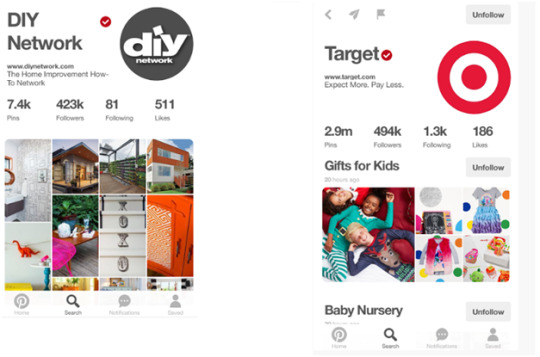
Looking at Pinterest from the outside, it’s clear that, while I don’t prefer it for personal use, much of the Pinner community has not yet given up on the platform. For now, it’s still a place for brands and businesses to get creative with all of their marketing, communications and advertising campaigns, and I would still advise them to.
0 notes
Text
This week: Instagram
aka

This week I finally dived into – or onto – Instagram, even though, having been preoccupied with school and other obligations, the only diversion I thought I could afford lately was to watch The Bachelor (not sure I should admit that) – while checking email, of course. As far as my relationship with social media’s ‘usual suspects’ goes, I have not logged on to my Twitter account in nearly a year, and due to the above-noted obligations, never even started with Facebook. That’s why it seems unlikely that I could find time for another social media platform, but Instagram is very different - - stick with me for a few here, and maybe you’ll agree.
Founded in 2010 and sold to Facebook in 2012, Instagram now has over 1 billion users, with only slightly more female users than male. I found it interesting that 35% of U.S. teens prefer Instagram over other social media and 73% of U.S. teenagers say the platform “is the best way for brands to reach them.” These percentages confirm that the mega-popular image-based app is Snapchat’s closest competitor, but even so, 37% of US adults (and 25 million businesses) also use Instagram, and over 60% of all Americans use it daily, captivated by images like this one:
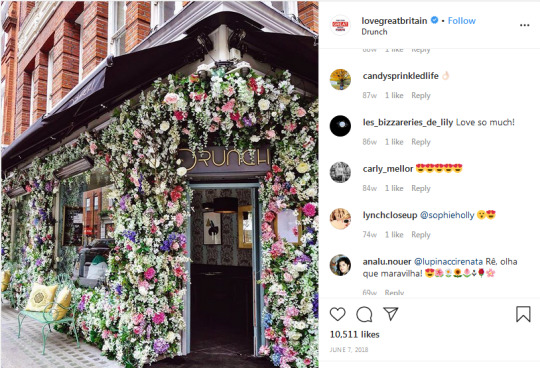
Previously, without an Instagram account, I heard about posts or campaigns on it only if they were featured in other news or in articles I read. From that, I really liked Smirnoff’s Instagram Your Fridge campaign, which invited people to post a photo of their open fridge, after which a mixologist, in a brief video, would create a cocktail using only ingredients seen in the fridge. Now, with a new account, I decided to look at what other brands are doing on Instagram, curious about how they inspire engagement. But first, I needed to see what the platform’s most popular brands were, and not surprisingly, they’re in the categories of fashion, sports or sportswear, food, travel and beauty, although Lego is very popular too.

With Instagram, both businesses and individuals try to post interesting and/or attractive images, but brands usually post user-generated content as well as their own, perhaps because they are aware it leads to more conversions. I would say that brands should also advertise their Instagram campaigns in other social media, as there is no guarantee that their fans will search for them inside of Instagram with so many other visual distractions. When appropriate, brands should include questions in their posts, as this naturally encourages engagement in all social media.
On this platform, videos get twice as much engagement as photos, but from what I observed, brands are using artistic or striking photos more than videos:
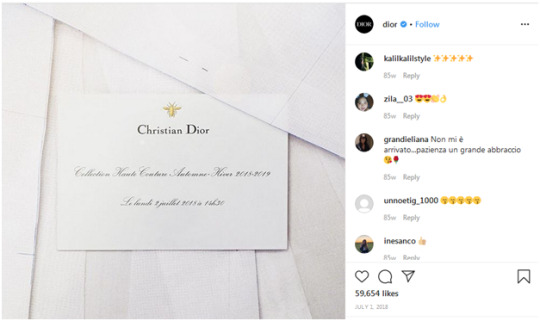
And there are always celebrity shots that seem to be striving for envy as well as engagement:

Not to mention the endless shiny objects… a.k.a., the attractive products artfully photographed by brands:

….which brings me to why Instagram is so different, or at least part of why, and it might explain why the app is growing so quickly. While other social media also features photos, videos and the ‘like’ option, other platforms are generally heavier in text. Of course, text is great when information sharing is key, but the conversational nature of most social media often leads to disagreement and negative back-and-forth carried out on forums meant for peaceful exchange. On the other hand, Instagram’s focus on images demands less conversation and engenders more positive engagement overall, and people need that positive break. In fact, Instagram is like an easy stroll in a scenery-filled park, which translates to an easy scroll through a scenery-filled phone.
I can handle that.
In my next Instagram session, I might even look up a brand whose products interest me, and it is all about people gravitating toward their interests, isn’t it? On this vein, I asked, “What would I like to see more of? What is something I find visually attractive most of the time?” I had to think, but came up with “crystals.”

So there. Instagram got me.
0 notes
Text
From magazine to online magazine: The Atlantic
This week, I wanted to look at a website that is based on a longstanding magazine, but not with a focus on the demise of the print magazine industry or on how it’s surviving in an online marketplace. Instead, I wanted to look at an online magazine in terms of my experience with it as someone who might buy a physical magazine once in a long while, usually when travelling, but who doesn’t subscribe to any printed or online periodicals. So enter The Atlantic.
Launched in 1857 as “a literary and cultural commentary magazine,” The Atlantic Monthly’s founders included Ralph Waldo Emerson and Harriet Beecher Stowe, and in the years following, it published work such as that of Mark Twain, Ernest Hemingway and Martin Luther King, Jr. Today, as The Atlantic, it publishes ten issues a year as an “editorial magazine primarily aimed at … serious national readers” and has over 500,000 print subscribers and “more than 40 million” unique monthly visitors at TheAtlantic.com. I’ve also learned that, among “general news magazines, the Atlantic has the most affluent readership.”

While I’ve never subscribed to The Atlantic (printed or online), I’ve heard of it via references to its content from other online news outlets and have browsed the physical magazine while in hospital and other waiting lounges. At TheAtlantic.com, I clicked on an article that would have caught my attention in a printed edition - “100 Years Ago in Photos: A Look Back at 1920” - and of course the photos were just as fascinating as they would have been in print:
“Scanty” swimsuits in 1920:

The word “amazing” is so over-used today, but it applies to this 1920 journalist in her part-time job:

For someone who has enjoyed print magazines, a few things are clear about a well-crafted online magazine that began in printed form:
1. Whereas the printed version was limited to the pages in your hand, the online multi-media version is much more expansive, and it’s usually connected to an archive of past issues and photographs, staff information and the magazine’s history.
2. Some magazines run such great photos that you might occasionally see an image you want to put on your wall right then (maybe that applies only to nerds like me, not sure). With the printed magazine, you’ll get your wish right away if you’re careful not to wrinkle the page when you remove it, and with the right printer and less carefulness, the digital magazine allows that same quirky but simple pleasure.
3. We gain a timelessness with online magazines, even though the printed monthly, or even weekly, magazine was never intended to provide up-to-the-minute coverage of sudden newsworthy events. Due to the instantaneousness of the Internet, while their latest online edition remains as static as the printed version, magazine websites are tempted to provide a dynamic ‘front page’ of quickly-revolving articles on more immediate topics or even daily news. The Atlantic is no exception, so it offers a daily email newsletter on weekdays, as you see below.
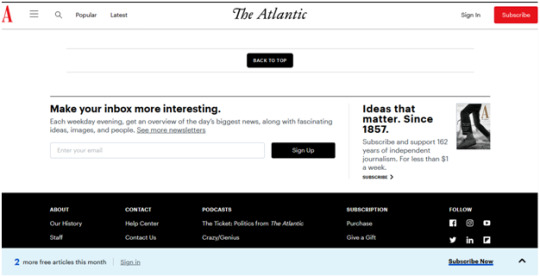
It is generally accepted that advertising is much more expensive in printed magazines than in online magazines, but according to chron.com, print ads “can be equally cost-effective in terms of how many sales they bring in per dollar spent.” Because The Atlantic is popular in both digital and print formats, it can be a great communications vehicle for brands and businesses with a similar audience (affluent, serious), whether they are primarily online or offline. I believe positive earned media is always preferable if a business can secure it, especially in a magazine, but securing an ad in the high-quality and dual-format Atlantic may be just as rewarding.
Overall, the online Atlantic, when compared to its printed counterpart, reflects the same brand but delivers a different experience and a different set of rules, yet the common denominator is the product. Interesting and well-written articles, compelling images and a unique but familiar ‘feel’ are the hallmarks of our longstanding printed magazines, and it takes thoughtful and careful work to retain these elements when translating a print magazine to an online forum. When it is done well, you get the sense that the printed periodical has simply moved to another medium, and the fact that it has moved to an entirely different technology, mindset and rulebook is much less apparent.
0 notes
Text
This week’s brief platform review: Reddit
https://www.reddit.com/
I had never used, or even visited, Reddit before today, but right away I thought its tagline was very clever - “the front page of the internet.” Sure, I knew about Reddit from the many references to it in other online blogs, news sites and social media, but I was busy with other online distractions, such as the news site that conveniently handles my email as well (which I'd rather transfer from than name).

What I didn’t like, also right away, about Reddit is the cartoon-based site design and theme. Really, if it’s not a site for children, then why? Or all we all just being dumbed down slowly, or not so slowly, but surely? I also expected to see an “about” link at the top of the home page and wondered, for a moment, if Reddit even had one. I found it by scrolling – and scrolling – past a default feed to the very bottom of the page, where it is part of a list in small print. Founded “by two college friends” (which social site isn’t?), I guess Reddit expects you to know about it already.
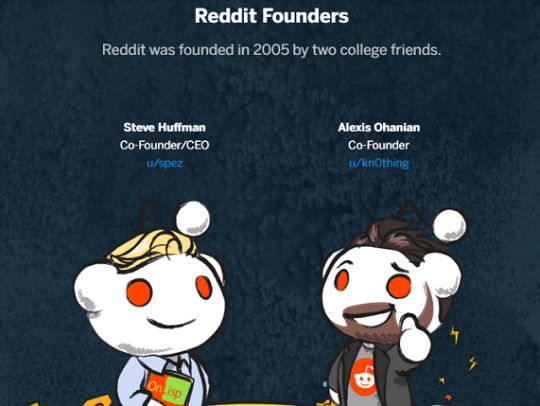
In any case, at https://www.redditinc.com/, the separate introductory page, Reddit says “The Conversation Starts Here” (another good line), and I learned that the site is “home to thousands of communities, endless conversation, and authentic human connection.” I also learned that each day “millions of people around the world post, vote, and comment in communities organized around their interests.”
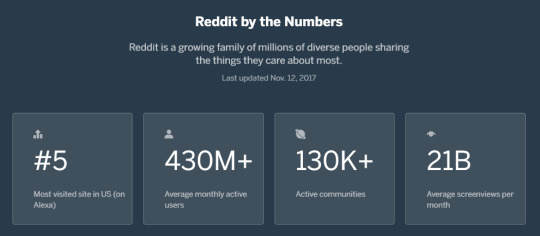
Reddit is truly a respectful free-for-all that rates highly on transparency (per their own blog) and has a nice and simple set of rules for what can and cannot be posted. Because of its follower size and large variety of interest-based themes, the overall Reddit community is not one that can be pinned down other than to say it probably represents the best of the overall Internet community due to its reasonable restrictions on certain violent and abusive content. I really appreciate the option to tag your own Reddit posts as “NSFW (Not Safe For Work) content,” which is an especially considerate touch.
After signing on I was prompted to select from a list of community themes, and to choose “at least 5” because Reddit somehow functions better that way.
So…. from the endless ‘personalized’ feed that followed, I started with this photo that caught my attention:

(Some of the funnier comments on the above photo, as you might guess, were on whether the boy in the background is a young Donald Trump or just the “first assassination attempt.”)
Then I went to ‘World’s worst cat’ up for adoption at North Carolina shelter. ‘She’s just a jerk,’ which links to the Charlotte Observer news site it came from (https://www.reddit.com/r/nottheonion/comments/esuy82/worlds_worst_cat_up_for_adoption_at_north/).
About 20 minutes later I ended my intro to Reddit with ‘A kid who hangs out by my work draws pictures for $5. I told him I wanted "the weirdest thing you've ever made" this was the result. Best $5 ever’ (https://www.reddit.com/r/pics/comments/esngt8/a_kid_who_hangs_out_by_my_work_draws_pictures_for/ ), which had me questioning the age of said “kid” in my first comment.
And that’s it – just distracting fun, for the most part. If you’re longing for a more considerate and censorship-free Facebook feed, which is not likely to happen, then definitely consider an account on Reddit. It can serve a communications strategy very well due to its emphasis on niche groups; within the forum’s many interest-based communities, businesses can find and speak to at least some members of their audiences.
0 notes
Text
This week’s media platform foray: Brighteon
(https://www.brighteon.com/)
Brighteon is a newcomer video platform launched on the premise of freedom (as well as on the premise that Youtube censorship has gone too far). In fact, it is meant to be the answer to Youtube’s censorship or outright removal of non-mainstream political, scientific and investigative videos. It was launched by Mike Adams, the “Health Ranger” who also runs NaturalNews.com.
Visiting this platform, you’ll see video titles peppered with “red alert,” “Warning” and “Urgent,” and you just might feel that either the world is truly on the brink of a disaster, or you’ve stumbled on a forum for exaggerators (I think both would be true). If so, I get it, but if you’re completely unfamiliar with what a good number of us (that’s my statistical reference) apparently view from time to time, then be sure to check out Brighteon to expand your neighborly awareness, if nothing else.

Brighteon is not my usual platform for video consumption because, like most of us, for videos I go straight to Youtube first. However, I do have an open mind, unlike so many of us who just say they do, and Youtube has begun to insert its own mainstream views into user videos that contain opinions or science that contradicts what we find in school textbooks. An Encyclopedia Brittanica quote, of all things, is often superimposed onto videos that explore or make the case for scientific contradictions. Such is the case with Bart Sibrel’s videos (like the one pictured below), which are now harder to find on Youtube unless you search for his name as well because ‘moon hoax’ searches now lead you to “debunkers” of such “conspiracy theories.”

From what I could gather, right now in its early stage the Brighteon community is somewhat diverse but very political and mostly white. I did not see any brand-name or organization videos, unless you count Alex Jones’ InfoWars. As you might know, Jones was banned from both Youtube and Facebook for non-violent but controversial videos, but he is slowly growing his viewer base once again on Brighteon, where the promise is that “[f]ree speech lives here.” In any case, the other promise from this platform appears to be ‘No, Virginia, there is no Santa and the world is rife with conspiracy all year long.’
My impression about the Brighteon community is that it values freedom and wants to maintain a censorship-free Internet, just like the forum’s founder. However, and also like the forum’s founder (and Alex Jones), many of the video makers engage in exaggeration with their titles. For example, “Battery Hacks That Might Save Your Life!” was just a couple of ways to rig a missing battery in your flashlight or small AAA-powered device. And when I bravely clicked on “THE MOST DANGEROUS THREAT NOBODY TALKS ABOUT!” the “threat” in question? “Government” – of any kind, anywhere. To be fair, there is good information to be found on Brighteon as well, especially related to health freedom and alternative health.
In fact, it’s the lack of censorship on Brighteon that makes its small inconveniences so much smaller. For example, topic categories are not well organized, so you might find a video under “Science and Technology” that should really be under “Politics.” And where else would you find a story about lights on a marijuana farm under “Home & Garden”? In addition, you can’t scroll over a partial title to see what the rest of it is, as you can in Youtube; you have to click on the video to read the full title.
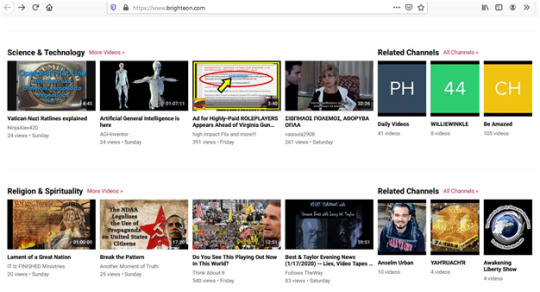
The lack of censorship on Brighteon leads to a much more important concern as well: the possibility that it will become a platform associated with hate groups, whether by actual hate groups or falsely-planted videos (see? I visited the site too long!). I do think violence-inciting videos should be banned, but Youtube and other major social media platforms go much further than that – they unfairly censor alternative science, investigative reports, unpopular political views (or views that platform owners disagree with), and alternative health information. As this short Brighteon video shows, we can do our part to counter that and remain free: https://www.brighteon.com/5817754193001
My hope is that Brighteon will be the platform that balances true freedom with reasonable censorship that targets only violence-promoting videos. It takes time to tell, though, so stay tuned.
1 note
·
View note